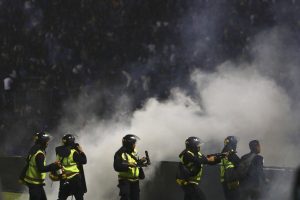Two weeks ago, this column discussed the Indonesian Supreme Court’s decision to slash the sentences of four convicted murderers, including two police officers, after the defendants appealed their guilty verdicts following the slaying of a young police brigadier.
This week, we are back with the Supreme Court and its panel of judges, who have overturned the acquittals of two police officers accused of negligence leading to death and injury in relation to the Kanjuruhan Stadium crush.
While sentences are infrequently downgraded on appeal in Indonesia, the Supreme Court reminds us that these are likely to increase, yet the perceived meager sentences of 2.5 and two years in prison for the police officers in question could be seen as rubbing salt into already deeply inflamed wounds.
The Kanjuruhan tragedy took place on October 1 last year in the city of Malang in East Java, when police fired as many as 45 rounds of tear gas at supporters following a match between rival soccer teams Arema FC and Persebaya Surabaya that ended in a perceived pitch invasion by disgruntled Arema FC fans.
In the ensuing chaos, fans in the 13th and 14th tribunes, where the gas was most concentrated, scrambled for the exits. Some 135 people, including children as young as three years old, died in the melee – crushed to death against metal gates and each other, and choked by the noxious gas which reportedly dated from 2019 and had expired.
All of this was caught on camera, with professional journalists and photographers already on the scene to capture the soccer game, and thousands of supporters with mobile phones frantically filming and uploading the unraveling chaos as they tried to escape, leaving a long trail of digital forensics in their wake.
Yet despite the overwhelmingly clear picture of what had happened at Kanjuruhan, and a report by Indonesia’s Human Rights Commission (Komnas HAM) released in November, which placed the blame squarely on the police’s excessive use of force, two of the three police officers on trial walked free in March of this year.
Now that unpopular decision has been overturned by the Supreme Court, and the two officers, Wahyu Setyo Pranoto, the chief of operations of the Malang Regency Police, and Bambang Sidik Achmadi, the head of the Prevention Unit of the Malang Regency Police, have been sentenced to 2.5 and two years in prison respectively – just shy of the three-year terms sought by the prosecution.
At the original trial at the District Court in Surabaya, another police officer, the commander of the 3rd Mobile Brigade Company of the East Java Police, Hasdarmawan, was sentenced to 1.5 years in prison for his role in the incident. Two civilians, security officer Suko Sutrisno and match organizing committee chairman Abdul Haris, were also separately sentenced to 1 year and 1.5 years after also being found guilty of negligence.
In total, with the two new sentences handed down by the Supreme Court, that amounts to 8.5 years in prison across five defendants for a wholly preventable tragedy in which 135 people died.
Is there much to celebrate?
One of the main legal sticking points of the case lies in the weeds of Indonesia’s Criminal Code and the choice of articles under which the accused were charged.
Early on, the decision was made by the authorities to charge all five men under a range of articles including Articles 359 and 360 of the Criminal Code, which cover negligence leading to death or injury, and carry a maximum sentence of five years apiece, setting a low bar for those looking for a hefty sentence.
Some in Indonesia’s legal community have argued that the men should have been charged with premeditated murder under Articles 338 and 340 of the code for which the maximum sentence is death, although this does not really stand up to scrutiny.
The key component of articles 338 and 340 requires an element of premeditation – that all five men, in the lead-up to the game at Kanjuruhan Stadium that terrifying night, planned to take the lives of the 135 souls who died there and actively behaved in ways to ensure that this would happen.
Despite a multitude of conspiracy theories that have sprouted online since the incident, including that police actively locked the doors of the stadium to gas supporters to death, there seems to be scant concrete evidence to support the theory that anyone set out to commit murder at Kanjuruhan Stadium, much less that it was planned in detail in advance.
Some would argue that arming the authorities with tear gas in the first place, something that is strictly prohibited in stadiums by FIFA, the body that regulates soccer games around the world, means that the police were aware of the possibility that they would deploy it at the game, but this in itself does not premeditated murder make.
While the Kanjuruhan Stadium crush is often seen as a test of police accountability in Indonesia, it is also perhaps a test of the country’s Criminal Code and whether its articles are fairly and evenly applied.
In the case of Kanjuruhan, while the length of the jail terms could have been more robust, the legal standing of the charges and the wholly correct decision by the Supreme Court demonstrates a legal system that still plays by the rules.
































